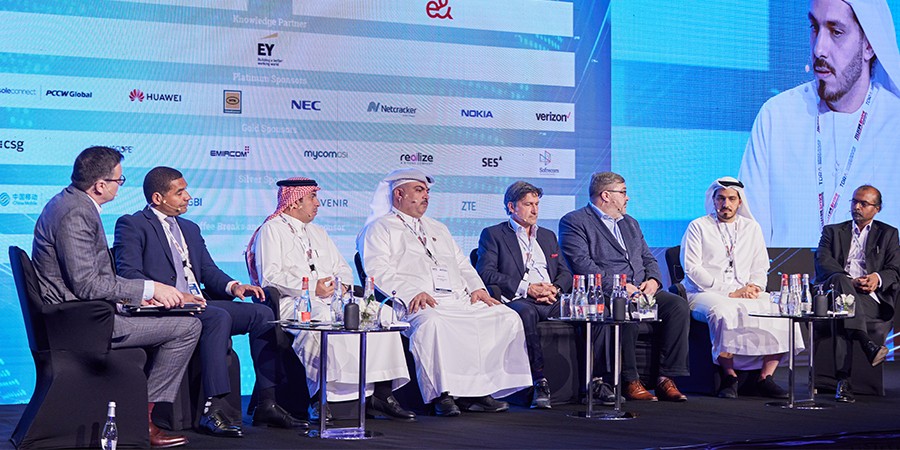During the second day of the 16th Telecom Review Leaders’ Summit, this particular panel focused on fiber versus 5G, the pros and cons of infrastructure sharing and the right infrastructure investments for the future.
The panel’s moderator was Mikhail Romanov, EMEIA transformation leader, EY with the panelists being Fabio Fontana, CEO, ZeroPoint DC and chief growth officer, Tonomus.NEOM; Femi Oshiga, VP sales, service providers, CommScope MEA & APAC; Eng. Abdulrahman bin Hamad AlMufadda, CTO, Zain KSA; Deepak Winston, director, digital & emerging tech, EY; Walter Miron, VP networks, TELUS; Fahad Abdul Rahman Al Ali, CTO, stc Kuwait; and Abdullah Al Chaer, head of network quality and optimization, du.
Fiber vs. 5G
During the initial part of the panel, Romanov explored the topic of fiber versus 5G and how the panelists view these connectivity technologies working side by side.
For Al Ali, both fiber and 5G complement each other. “Last mile cannot be done without fiber backhauling,” he said. Agreeing to this point, Eng. AlMufadda believes that 5G will not eliminate the need for fiber.
Zain KSA is using 5G for the access side and fiber for backhauling — similar to stc Kuwait. Zain KSA managed to reach 63% of the population with 5G technology. This new market player brings cost efficiency as well as faster time-to-market and deployment.
Both fiber and 5G are needed to connect the unconnected and fill the internet gaps. Al Chaer stated that, depending on the use case, knowing which one is the ideal choice is determined. For enterprises with hundreds of data centers, 5G will not be economically feasible, but for greenfield operators that require quick access to market, 5G is the answer.
Miron pointed out that whether it’s a B2B or B2C situation, “we need to have the right access technology.”
Infrastructure Sharing
Al Chaer expressed that the infrastructure-sharing concept has evolved a lot in the last few years. Now, it’s a combination of active and passive infrastructure sharing. With this, a proper agreement framework must be in place.
In the UAE, the Telecommunications and Digital Government Regulatory Authority (TDRA) encourages tower sharing to avoid having multiple towers in close proximity.
For stc Kuwait, the introduction of tower companies (towercos) allows operators to focus more on innovation and digitalization. “Tower as a component is no more a competitive edge,” Al Ali mentioned. He also emphasized that they are the only operator that has a MVNO in the country, and they are a great player in fiber connectivity as well.
Having more advanced services than building infrastructure is a leverage that Zain KSA has pointed out. Focusing on improved CAPEX and customer experience, the operator is “not only sharing the infrastructure, but also sharing the active components.”
Fontana strongly believes in the ecosystem and said that “everybody should be sharing and give the customers the option to choose.” Requiring efficiency moving forward, Miron also added that “as we move our workloads, massively distributing our services, infrastructure sharing can affect overall services.”
As per EY, US$ 300 billion is already being spent on 5G, and interestingly, towercos are valued at twice the amount of operators. Winston offered that, “from a financial engineering perspective, towercos do not want to take any assets,” and that fiber will expand its usage from backhaul to front-and-mid haul.
Winston reiterated the question: if you have a trillion dollars, would you park it on towercos or on your own business? Fiber investment ROI usually take 8-10 years to materialize, which is why data center companies, service providers and telcos will instead opt to partner with towercos.
Investments
In du’s case, Al Chaer said that discerning the most viable investment is done by determining traffic growth and tech evolution. These include customer sentiments, network quality checks and benchmarks. He explained that they reallocate and readjust depending on the “technical and business requirements,” and they will keep building on top of that to drive the existing 5G infrastructure further.
Relatively, stc Kuwait takes digital transformation as a key pillar of their strategy. From transforming their front and backend systems into integrating robotics in operations, OSS is being done in an automated way via digital platforms and chatbots. “What makes us unique is how we not only focus in coverage but also customer experience,” said Al Ali.
Zain KSA aims to deliver more and more solutions addressing customers and different verticals, while TELUS makes connecting communities part of their long-term strategy. This will be adaptive to their geographical area and focus on an improved and digitized end-user experience.
NEOM’s investment in turning smart cities into cognitive cities will “maximize the use of data.” Not waiting for 2030, Fontana shared that they are “co-investing and co-sharing infrastructure,” especially with soft assets, leveraging cloud providers.
Oshiga shed light on the fact that most countries in the world have power as their biggest expense when building data centers. Helping operators and vendors deploy 5G — which is not cheap — is CommScope’s goal, which is manifested by “mirroring what the customers require from us.”
